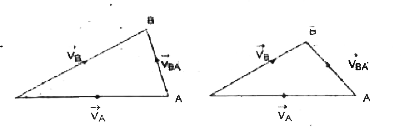In perfectily inelastaic collition the relative velocity of the bodies
before impect it zero
before impect is equal the after impact
before impect is zero
is characterized by none of the above
The correct Answer is:C
As in a perfectly inelastic collision, two bodies stick together after the collision and move with same velocity , so their releative velocity after the impact is zero.
Topper's Solved these Questions
- WORK, ENERGY, POWER AND COLLISIONBook:A2ZChapter:WORK, ENERGY, POWER AND COLLISIONExercise:Problems Based On Mixed Concepts
Explore 32 Videos
- WORK, ENERGY, POWER AND COLLISIONBook:A2ZChapter:WORK, ENERGY, POWER AND COLLISIONExercise:Assertion Reasoning
Explore 17 Videos
- WORK, ENERGY, POWER AND COLLISIONBook:A2ZChapter:WORK, ENERGY, POWER AND COLLISIONExercise:Circular Motion In Vertical Plane
Explore 21 Videos
- WAVES AND ACOUSTICSBook:A2ZChapter:WAVES AND ACOUSTICSExercise:Chapter Test
Explore 30 Videos
Similar Questions
Show that in a perfectly elastic collision , the relative velocity of seperation after collision is equal to relative velocity of approach before collision .
View SolutionShow that in case of one dimensional elastic collision of two bodies, the relative velocity' of sepa¬ ration after the collision is equal to the relative velocity of approach before the collision
View Solution
Knowledge Check
The ratio of relative velocity of separation after collision to the relative velocity of approach before collision between two colliding bodies is ____________.
Acoefficient of restitutionBvelocity of collisionCsum of the velocitiesDthe law of gravitationThe vector difference between the absolute velocities of two bodies is called their relative velocity. The concept of relative velocity enables us to treat one body as being at rest while the other is in motion with the relative velocity. This jormalism greatly simplifies many problems. If →vAis the absolute velocity of a body A and →–––(B)that of another body B then the relative velocity of A in relation to B is →–––(AD)=→VA−→vB and →vBA=→vB-→vA.
The principle follows here is that the relative velocity of two bodies remains unchaged if the same additional velocity is imparted to both the bodies. A simple way of carrying out this operation is to be represent the velocities in magnitude and direction from a common point. Then the line joining the tips of the vectors represents the relative velocity
Q A train A moves to the east with velocity of 40 km/hr and a train B moves due north with velocity of 30 km/hr. The relative velocity of A w.rt. B is A70 km/hr towards EastB10 km/hr towards North EastC50 km/hr at some angle South of EastD50 km/hr at some angle North of East.
A70 km/hr towards EastB10 km/hr towards North EastC50 km/hr at some angle South of EastD50 km/hr at some angle North of East.The vector difference between the absolute velocities of two bodies is called their relative velocity. The concept of relative velocity enables us to treat one body as being at rest while the other is in motion with the relative velocity. This jormalism greatly simplifies many problems. If →vAis the absolute velocity of a body A and →–––(B)that of another body B then the relative velocity of A in relation to B is →–––(AD)=→VA−→vB and →vBA=→vB-→vA.
The principle follows here is that the relative velocity of two bodies remains unchaged if the same additional velocity is imparted to both the bodies. A simple way of carrying out this operation is to be represent the velocities in magnitude and direction from a common point. Then the line joining the tips of the vectors represents the relative velocity
Q A river is flowing from west to east at a speed of 5 m/s. A man on the south bank of the river, capable of swimming at 10 m/s in still water, wants to cross the river without drifting, he. should swim Adue northB30∘ east of northC30∘ west of northD60∘ east of north
Adue northB30∘ east of northC30∘ west of northD60∘ east of north
In one-dimensional elastic collision, the relative velocity of approach before collision is equal to
View SolutionKinematics - Problems On Relative Velocity
View SolutionRelative Velocity|Questions
View SolutionIf the velocity of a body is constant:
View SolutionAssertion: A body,whatever its motion, is always at rest in a frame of reference which is fixed to the body itself.
Reason: The relative velocity of a body with respect to itself is zero.
View Solution

